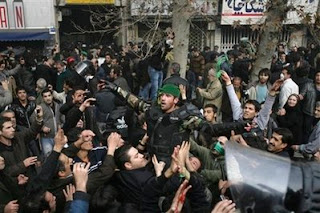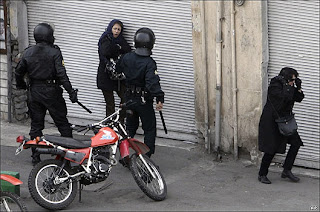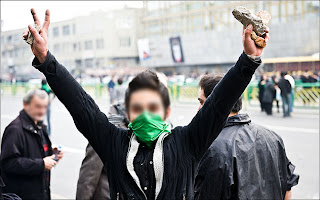This article has been written by Farnaz Fassihi, and it has been poblished by Wall Street Journal. Here is the link:
Regime Wages a Quiet War on 'Star Students' of IranAnd here is the article:
Behind the drama unfolding in the streets of Iran, the regime is quietly clamping down on some of the nation's best students by derailing their academic and professional careers.
On Wednesday, progovernment militia attacked and beat students at a school in northeastern Iran. Since last Sunday's massive protests nationwide, dozens of university students have been arrested as part of an aggressive policy against what are known as Iran's "star students."
In most places, being a star means ranking top of the class, but in Iran it means your name appears on a list of students considered a threat by the intelligence ministry. It also means a partial or complete ban from education.
The term comes from the fact that some students have learned of their status by seeing stars printed next to their names on test results.
Mehrnoush Karimi, a 24-year-old law-school hopeful, found out in August that she was starred. She ranked 55 on this year's national entrance exam for law schools, out of more than 70,000 test-takers. That score should have guaranteed her a seat at the school of her choice. Instead, the government told her she wouldn't be attending law school due to her "star" status.
Ms. Karimi says she thinks she got starred because she volunteered in the presidential campaign of opposition leader Mir Hossein Mousavi last spring. She also participated in several antigovernment "Green Movement" protests that are convulsing Iran.
"They tell me, 'You are not allowed to study or work in this country any more.' Why? Because I voted for Mousavi and wore a green scarf?" says Ms.Karimi in a phone interview from the city of Isfahan, where she lives.
More than 1,000 graduate students have been blocked from higher education since the practice began in 2006, according to statements by Mostafa Moin, a former education minister, in official media in September.
Star treatment is reserved for graduate students, although undergrads also face suspension for political activity, according to student-rights activists. Several hundred undergrads have been suspended for as many as four semesters, according to student activists and human-rights groups in Iran. Under Iran's higher-education law, students are dismissed from school if they miss four terms.
The phenomenon started in the summer of 2006, the first academic year in President Mahmoud Ahmadinejad's first term in office. Some grad-school applicants noticed stars beside their names on the report cards issued by the government-run college-placement agency.
Students with one star could return to school after signing a consent to give up political activism, according to Iranian human-rights and activist groups. Two-star students faced semester suspensions and interrogation sessions, and three-star students were banned from education for life.
The regime identifies star students by tapping the same network of security forces and informants it uses to keep society generally in check. The intelligence ministry routinely monitors email and phone conversations of people it considers dissidents and activists.
In December, after riots broke out on university campuses, Kamran Daneshjoo, Iran's minister of education, told ISNA, the official student news agency, that the government would identify "students who are havoc-makers" with the help of campus security and loyal professors.
To tell their stories, the students interviewed for this article switched between various phone numbers, email addresses and online chat services to minimize the chance their conversations would be monitored and potentially blocked.
Mr. Ahmadinejad has publicly denied accusations that his administration discriminates against activist students. In late 2006, Mr. Ahmadinejad made light of star students in a speech at Tehran's Amir Kabir University, a top engineering school. "I've heard some students have received three stars," he said. "I announced later that these gentlemen have become First Lieutenants."
Members of a student-rights group, the Committee to Defend the Right to Education, say the president's quip helped spur them to organize, after having made individual attempts to resolve their own problems with star ratings. The group began collecting documents and staging sit-ins at the ministry of education. At least a dozen members have been arrested in the past six months.
This past June, star students were a hot issue in Iran's presidential election. Mr. Ahmadinejad's rivals competed for the youth vote by pledging to return star students to school. At election rallies, some people chanted "Political students must be freed."
In a live debate on state television in early June between Mr. Mousavi and Mr. Ahmadinejad, the president again denied banning students from school. As the debate took place, a group of about 100 students -- wearing signs that said, "I am a star student" -- staged a silent protest outside the studios of Iran's state-owned TV network.
Phone calls by The Wall Street Journal to the public-relations department of the Sazman Sanjesh Amouzesh Keshvar, the government agency responsible for higher-education exams and placement, weren't returned.
Iranian students have a long track record of political activism. After the Islamic Revolution of 1979 toppled the then-king, Shah Mohamad Reza Pahlavi, universities underwent massive purges of students and professors considered disloyal to the Islamic regime. The process was known as the Cultural Revolution.
Students accepted to public universities (which are generally better and more competitive than private schools) were screened for moral behavior and for loyalty to Islam and the new regime. Still, the practice, known as gozinesh, didn't ban individuals. Applicants could reapply again and again.
Gozinesh ended in 1997 when new leadership came to power and rolled back some social restrictions. Today, activists blame Mr. Ahmadinejad not only for resurrecting the screening process but also for adding an element of punishment by imposing the lifetime education ban on star students.
"The government is extremely terrified of student uprisings because they are young and idealistic and have shown over and over that they are willing to stand up for injustice," says Saleh Nikbakht, a lawyer who represents several star students, reached by phone in Tehran. "Iranian universities are like a ticking bomb."
In the current academic year, about 89 students were given three-star labels, according to the student-rights group, including some of the nation's top performers on admissions tests. Dozens appear to have been banned because they participated in protests and volunteered for opposition presidential campaigns, the group says.
The student-rights committee made available to The Wall Street Journal report cards belonging to 63 star students from the past four years. The documents indicate the students' test-taking rank and the enrollment capacity in their chosen fields. In the cases reviewed, the students were comfortably within the bracket of acceptance.
Ali Qolizadeh, a 25-year-old with an undergraduate degree in engineering, ranked 43rd among 25,000 participants in the placement exam for an M.B.A. According to his report card, the M.B.A. program accepted about 3,211 students nationwide.
Mr. Qolizadeh was the spokesperson for his university's chapter of Fostering Student Unity, the country's best-known and most politically active student group. He was also the editor of a student publication called The Culture to Resist, which published with a permit from his university and was dedicated to essays about politics, economics and the arts.
The disciplinary committee suspended him for four semesters because of his political activity. He also was arrested and spent 21 days in solitary confinement, he says.
"Suspension is the worst feeling in the world. You are just spending your time idly as your friends go to school and you have no idea what will happen to your future," said Mr. Qolizadeh in a phone interview from the city of Mashad. As the only son of a working-class family, he says, he felt a particular obligation to finish graduate school and get a solid job to help support his family and three sisters. He is currently unemployed.
Over the past week, Mr. Qolizadeh says -- following last Sunday's major outbreak of street violence -- 25 of his university friends have disappeared with no news.
Contending with Iran's youthful population is one of the Islamic Republic's biggest challenges. Some 60% of Iran's 75 million people are under the age of 30, making the country one of the world's youngest. That means most citizens were born after the 1979 revolution that defines modern Iran and thus have no personal memory of it.
The student crackdown is part of a broader pattern of social control that is a fact of life in Iran. Mr. Ahmadinejad has tightened the rules since coming to power in 2006. Morality police patrols, which check people's attire for conformance to Islamic law, are back on the streets. Private social gatherings are at risk of being raided if drinking or dancing is observed.
Dissent can lead to loss of social status or jobs. Resentment over the tighter enforcement has helped feed the fires of protest.
This year, hundreds of students have been arrested and jailed. Three starred students not named in this article, but interviewed during its preparation, were arrested the Sunday before last while traveling to the city of Qom to attend the funeral of Ayatollah Hossein-Ali Montazeri, a revered cleric and outspoken critic of the regime.
Soroush Sabet, a 24-year-old from the southern city of Shiraz, ranked No. 1 in placement testing for a graduate degree in sociology that enrolled 3,386 students, according to his government-issued report card. But in August, he says, his applications were denied. He was told he is on this year's list of three-star students.
A top performer for years, he graduated with an engineering degree from the prestigious Iranian engineering school, Shairf University, from which many U.S. universities recruit graduate students.
About two years ago, as an undergrad, Mr. Sabet became involved in a socialist student group. In December 2007, security agents raided one of the group's meetings and arrested 50 members, including Mr. Sabet. He spent 47 days in prison, 23 of them in solitary confinement, he says.
He was charged with threatening national security and released on bail, and allowed to go back to school after signing a form saying he would never take part in activism again, he says.
Mr. Sabet suspects he was starred at least partly because of his switch to social studies from engineering, combined with his record of activism. Iran's leaders have expressed deep skepticism toward social-studies curricula: In September, Supreme Leader Ayatollah Ali Khamenei gave an unusual speech in which he said the social-studies programs at Iranian universities promote secularism and Western values.
In October, the Revolutionary Court sentenced Mr. Sabet to two years in jail, he says. He is awaiting an appeal hearing that he hopes will ease the sentence.
"My dreams for going to school are finished," he said in a telephone interview from Tehran. "I am now just praying I don't go to jail."
Since August, Mr. Sabet, as well as Mr. Qolizadeh and Ms. Karimi, have traveled to Tehran by bus to follow up, together and individually, on their application status.
In September, the three visited Parliament to seek help from lawmakers. On the way out of the building, they said, security forces detained and questioned them for two hours. "They told us we look suspicious and they thought we are handing out opposition fliers," says Ms. Karimi.
This month two of the lawmakers they spoke with wrote back, the students say, to apologize for not being able to help.
Ms. Karimi says that the first time a government official told her there was no hope she would ever return to school in Iran or obtain a government job, "It felt like someone had hit me on the head. I couldn't really hear what he was saying anymore."
"They basically told me that as far as they are concerned, I am a dead person," Ms. Karimi says.


























































